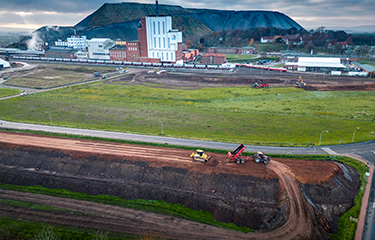Aquapurna and Billund Aquaculture have begun work on the world’s largest high-intensity recirculating aquaculture system shrimp farm.
Design of the farm is advancing and construction will begin in January 2024 on the 18,000-square-meter facility at the Sigmundshall Industrial Site near Wunstorf, Germany. Aquapurna and Billund, which formalized their joint venture in 2022, said they hope to introduce the first shrimp larvae into the farm by the end of 2024. They eventually plan to produce 800 metric tons of vannemei shrimp annually at the site.
“Having surpassed all objectives in lab-scale trials and commercial prototypes, the joint venture is preparing for large-scale production,” Annapurna and Billund said in a joint statement. “The facility will serve as a large-scale proof of concept, showcasing the expertise developed by both companies over the past few years. Aquapurna has been perfecting a unique shrimp-farming system, while Billund Aquaculture has been providing state-of-the-art water treatment technology to the project.”
Kassel, Germany-based K+S, a supplier of minerals and other raw materials, has invested more than EUR 10 million (USD 10.8 million) in the project, and Aquapurna has received a separate investment of at least EUR 1 million (USD 1.1 million) from private investors from the food and retail sectors to support construction costs.
“Together with the globally operating industrial company K+S, we are making a significant contribution to sustainable and autonomous food supply in Europe,” Aquapurna Managing Director David Gebhard said.
Founded in 2020 as a land-based aquaculture technology specialist, Aquapurna already operates a research and development center at the Sigmundshall site, where it has developed a vertically integrated larviculture system and hatchery, with the goal of creating a cost-efficient, sustainability-focused shrimp RAS model. It also produces and markets shrimp for retail customers under the Gamba Zamba brand. Aquapurna CTO and Co-Founder Florian Gösling said the project is specifically designed to prove its model works at large scale and high densities.
“The synergy between our extensive knowledge in land-based shrimp farming and Billund's track record in establishing large-scale farms for various species proved to be the ideal fusion for pioneering the first large-scale, state-of-the-art shrimp recirculating aquaculture system,” Gösling said.
The farm will be built in three phases, with the eventual goal of building two production halls with a floor area of approximately 18,000 square meters. Phase 1, to be finalized by mid-2025, will involve the construction of a 4,000-square-meter production hall and supply and infrastructure wing.
“Once the first farming module has proven stable operation, the farm's production capacity will increase sixfold,” Gösling said.
Thanks to K+S’s contribution of land and physical plant at the Sigmundshall Industrial Site, the JV has the capacity to add six additional RAS modules, covering a total area of 30,000 square meters. The farm will eventually be equipped with solar panels, and 98 percent of the water used in the grow-out tanks will be reused.
Aquapurna CEO David Gebhard said the company hoped to create a scalable solution to allow for local shrimp farming across Europe.
“[We want] to supply the world with delicious shrimp while protecting the planet,” he said.
Billund, Denmark-based Billund Aquaculture is a specialist in the design, implementation, start-up, and servicing of RAS farms, having developed more than 140 projects around the globe.
"Throughout this period, we have challenged each other, our choices of technology and the pros and cons of different solutions,” Billund Aquaculture Chief Sales Officer Bjarne Hald Olsen said. “A lot of work has been done behind the scenes to find the most efficient setup, which has led to many internal discussions and decisions."
Photo courtesy of Annapurna/Billund Aquaculture







